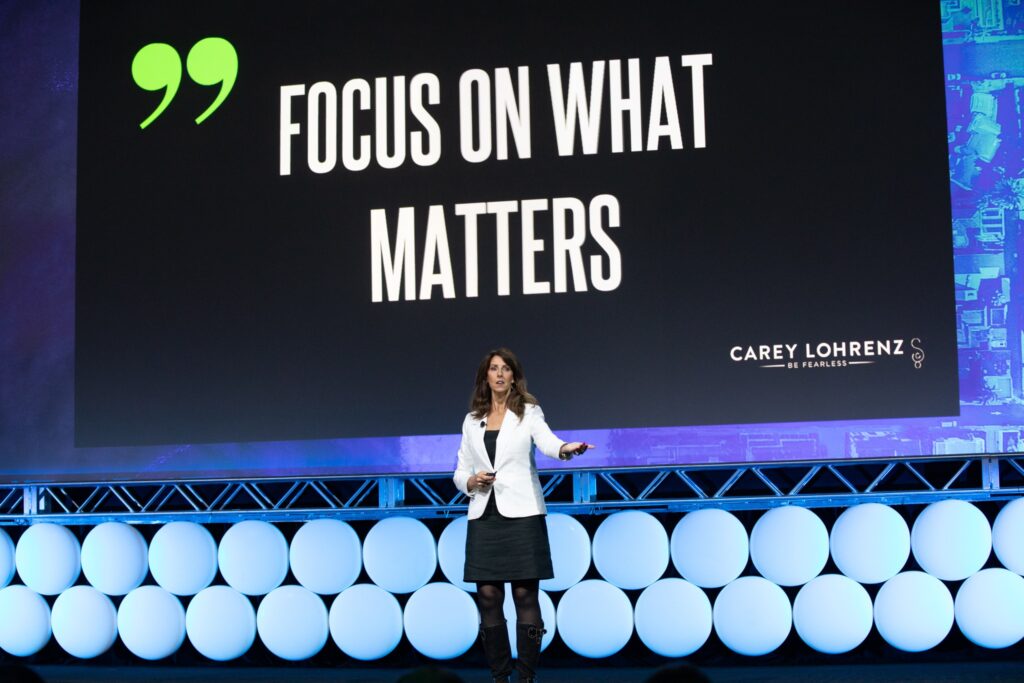In today’s fast-paced world, the ability to navigate turbulent environments is more important than ever for leaders, executives, business owners, and entrepreneurs. Leading through change is an essential skill in today’s fast-paced world, where agility, resilience, and forward-thinking are necessary to navigate uncertainty.
Leading through change not only fosters personal success but also contributes to the growth and sustainability of the organizations these leaders represent, as they harness opportunities and tackle challenges in an ever-evolving business landscape.
As one of the first female F-14 Tomcat fighter pilots in the US Navy, I know well that inconsistent execution in fast-moving, dynamic environments can generate catastrophic results.
The cockpit of an F-14 is one of the most demanding environments on earth. And, it’s where I learned some of my most unforgettable lessons not just in flying, but also in life, and in leadership.
My path after leaving the military—working among business leaders from Fortune 500 and Forbes Global 2000 executives to middle managers, from business owners to entrepreneurs to high-performing athletes—has shown me that there are real opportunities for success even in times of crisis and uncertainty.
Change Leadership
The biggest challenge leaders face today is not just guiding their organizations through change, but also being the catalysts for that change. Change is often met with resistance. Leaders must overcome this inertia by fostering a culture that embraces change and empowers employees to adapt and grow.
Above all, the ability to lead through change is not only necessary, but it’s also the key to unlocking a world of new opportunities and growth.
You will run into turbulence. You Will feel vulnerable at times, there is no doubt.
How can you be successful anyway?
Leading through change is a crucial skill for today’s fearless leaders. So, buckle up, and let’s navigate this uncharted turbulence together!
First, let’s dive into the science behind effective change leadership and explore actionable strategies to help you steer your organization toward success.
Here are five impactful and effective strategies for leading through change:
- Create a compelling vision: A clear and inspiring vision helps employees understand the purpose behind the change. A clear vision will inspire and align your team. It’s imperative that you, as a leader, step up and provide that vision that empowers the team to achieve high performance. By articulating a compelling vision, leaders can motivate employees to embrace the change and work towards a shared goal.
- Engage in open communication: Part of being a fearless leader hinges on your ability to communicate effectively. In times of uncertainty, it is crucial for leaders to communicate clearly and transparently with their teams, stakeholders, and customers. This can involve providing regular updates on the organization’s situation. Including: sharing information about the challenges and opportunities that the organization is facing, and being open and honest about any uncertainties or risks. By communicating clearly, leaders who communicate effectively: alleviate fears, clarify expectations, and build trust. This creates a supportive environment for change to flourish.
- Empower employees: Too often, organizations and individuals will spend time crafting a mission statement or holding endless meetings, and then just start executing. We included many different people and teams in the planning process from the outset to gain buy-in. When you create buy-in, everyone involved in execution, from the C-suite to the frontline worker, understands the strategy. This is critical for employee engagement.
- Provide ongoing support, training, and prepare relentlessly: Now that you know your vision and goals, the question to ask is: How do you achieve results consistently, even if you face adversity and change? The answer is simple: through relentless preparation and training. Insistence on preparation is one of the priceless gifts a fearless leader can offer his or her team. Accordingly, leaders who invest in continuous development and preparation demonstrate their commitment to employees’ growth and success. This leads to increased engagement and retention during change.
- Celebrate small wins: Fearless leaders celebrate success and achievement in small, simple ways. These gestures go a long way toward maintaining morale, boosting momentum and even reinforcing the upsides of change. By acknowledging the small wins, leaders can create a virtuous cycle that encourages employees to persevere and strive for greater accomplishments.
Building a Culture of Change
The ability to lead through change is an essential skill for managing uncertainty, and overcoming resistance to change. To successfully lead through change, leaders must be flexible, resilient, and empathetic.
By implementing these effective change management strategies:
- creating a compelling vision
- engaging in open communication
- empowering employees
- providing ongoing support
- celebrating small wins
You can navigate the turbulent waters of change and guide your organizations toward a brighter future.
By embracing change and employing evidence-based strategies, leaders, YOU can inspire your teams to adapt, innovate, and thrive in the ever-evolving landscape of modern business.
Remember, the most significant opportunity lies not in avoiding change, but in harnessing its power to create a lasting, positive impact.

Carey Lohrenz, Keynote speaker, bestselling author, CEO








1 Comment